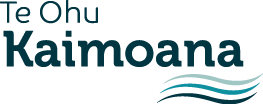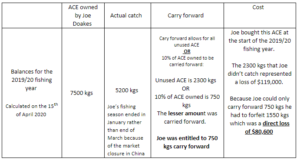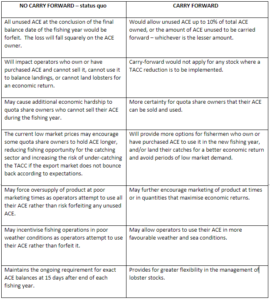Carry forward explained
For most fisheries (apart from fish stocks listed in Schedule 5A of the Fisheries Act 1996), either all unused ACE OR 10% of ACE owned by an individual—whichever is the lesser amount can be carried forward into the next fishing year, provided the stock is not subject to a Total Allowable Commercial Catch (TACC) decrease in the following fishing year. Carry forward applies to ACE holders who have unused ACE at the end of the fishing year. Rock lobster and packhorse lobsters’ stocks are listed in Schedule 5A—meaning that carry forward doesn’t currently apply in any of these stocks.
Rock lobster, pāua and some other shellfish were originally excluded from being able to carry-forward unused ACE as they are single species target stocks—these species can be harvested with little or no incidental capture of other quota management species.
Carry forward was primarily designed for mixed species fisheries. It was acknowledged at the time that when bulk harvesting, it is impossible to predict the mix of species that will be caught. Therefore, there was little certainty the whole TACC could be caught so carry forward would allow for some wiggle room in these circumstances.
Single species target stocks were not considered to need this provision because it was easier for fishers to catch or trade their ACE with someone else who could catch it by the end of a fishing year. However, neither industry or government anticipated a situation where market access meant that lobster could not be exported or could only be sold for low returns outside the live market.
In January 2020, around Chinese New Year, the Chinese market was effectively closed to rock lobster imports due to Covid-19. This is generally a time of peak demand and high prices for live lobsters. Because the Chinese market closed without any prior notice, many fishers and processors were left with large quantities of unused ACE. In addition, large quantities of live lobsters that were destined for the Chinese New Year Market were stored at land-based facilities or at sea holding pots.
In normal circumstance unused ACE for CRA and PHC would expire on April 15th, the last day to balance commercial landings for the previous rock lobster fishing year. After seeking the views of Quota Share Owners (QSOs), ACE owners and processors, the NZ RLIC sought an amendment to a schedule to the Fisheries Act that would enable some unused ACE to be carried forward into the new fishing year in an effort to offset the very significant impact of all unused ACE being forfeit. NZ RLIC also brokered the negotiation with MPI Compliance to allow for the supervised return to sea of lobsters in holding facilities subject to conditions. The holding facility lobsters would normally not be allowed to be returned to the sea.
In early March the Minister announced his decision to allow carry-forward for one year only. Carry forward into 2020/2021 was only applied to CRA stocks, not PHC. Carry forward into the 2020/21 fishing year was enabled for all CRA stocks apart from CRA1, as the Minister decided to reduce the TACC for this stock. CRA3 was also consulted on in the sustainability rounds for a Total Allowable Catch (TAC) and TACC reduction, which both Te Ohu and NZ RLIC supported. However, the Minister deferred the TACC reduction because the amount of under-catch was estimated to be greater than the intended TACC reduction. If he had made the TACC reduction the stock would have had both no carry-forward (an effective reduction intake) and the TACC reduction. CRA3 Iwi have expressed their disappointment in the Minister’s decision.
The rock lobster industry has been criticised for its reliance on the Chinese market, when in reality the Chinese market pays 40% more than the highest paying alternative market for New Zealand lobsters.
New Zealand lobster exporters have made significant efforts to develop other potential markets such as Japan, Malaysia, Singapore and the United Arab Emirates. The limited alternative markets are often driven by Chinese communities in those markets. However, those markets do not have sufficient demand for premium quality live lobsters and cannot take the quantities or pay the prices that are available in China.
If an event such as biotoxin event or another global pandemic where to occur then all ACE could not be caught. Availability of other markets would not assist in such circumstances. It would be preferable to put in place a mechanism available on an ongoing basis to help mitigate the impacts and increase the resilience of the rock lobster industry to market shocks that are not of our making.
No, carry forward does not increase the amount of fish that can be harvested, but rather changes the timeframe in which they can be harvested. Rock lobster has regular scheduled stock assessments and is closely monitored due to its value to customary, recreational and commercial sectors. Because of this we are confident that the TAC/TACC is set appropriately.
When the TAC/TACCs are set, the entirety of the TACC and allowances is assumed to be caught in that fishing year. The carry forward of ACE allows fishers to catch a portion of their unused ACE for a particular fishing year in the subsequent year. Where a carry–forward is applied, the amount of fish caught over a two-year period would not be greater than the two-fishing year TACC’s combined.
Carry-forward of ACE does not lead to any sudden increase in commercial fishing activity. If viewed in the same light as a modest TACC increase, the small amount carried forward is distributed across the fleet which itself is already geographically distributed across the extent of a fishery management area.
Carry-forward of up to 10% of ACE will very likely be spread in the usual manner across the fishing year and across the extent of fishing grounds as in any other season. There is no reason that operators would change their existing patterns of taking catch in particular areas. It therefore seems unlikely that carry-forward catch, spread in that manner, will have localised depletion affects.
No, carry forward does not increase the amount of fish that can be harvested, but rather changes the timeframe in which they can be harvested. Rock lobster has regular scheduled stock assessments and is closely monitored due to its value to customary, recreational and commercial sectors. Because of this we are confident that the TAC/TACC is set appropriately.
When the TAC/TACCs are set, the entirety of the TACC and allowances is assumed to be caught in that fishing year. The carry forward of ACE allows fishers to catch a portion of their unused ACE for a particular fishing year in the subsequent year. Where a carry–forward is applied, the amount of fish caught over a two-year period would not be greater than the two-fishing year TACC’s combined.
One-off carry-forward was a temporary fix – the rock lobster industry is still being adversely affected. The paper prepared by the NZ RLIC covers the extensive economic losses faced by the entire rock lobster industry.
The significant losses by fishermen and companies, and loss of revenue to Iwi, caused wider socio-economic impacts such as inability to service debt, impacts on services to iwi beneficiaries and reduced economic viability, impacts on regional communities and reduced economic activity for a number of associated servicing and support businesses. The rock lobster industry is very widely distributed in regional communities, with over 100 landing points throughout New Zealand.
Carry-forward allows for greater flexibility in the management of rock lobster
Similar levels of market disruption could occur again and there is currently nothing in place to alleviate the economic pressure that it causes. It is possible in the changing world we live in that market disruptions like Covid-19 will happen again, in the form of other pandemics or the occurrence of more frequent and intense biotoxin events. Currently no other options are being explored to offset the loss incurred by quota owners, fishermen, processors and exporters due to Covid-19.
Carry-forward of unused ACE can provide the industry with an important tool to partially alleviate the financial hardship caused by disruption to fishing. Carry-forward can mitigate the impacts of more than market access loss to China. It can also help address the impacts of increasingly frequent biotoxin events that could prevent harvesting. If that were to occur in an area late in the fishing year – ACE could not be caught. Availability of other markets would not assist.
If market access is hindered, or price is reduced, extending limited harvesting into the next fishing year provides the potential for a far better economic return for operators which can flow into the regional businesses and communities where the industry is located. If market access is temporarily curtailed, carry-forward allows deferral of harvest until access can be regained.
The pāua industry has seen the benefit in enabling carry forward – the rock lobster industry is likely to see the same benefits
Pāua was removed from Schedule 5A in 2011 to allow for carry-forward. The pāua industry has found carry forward to be beneficial as it provides for:
- flexibility in administration of the fishery
- greater ability to match product supply with export demand
- support for industry catch spreading arrangements; and
- reduced compliance costs associated with end of year ACE balancing.
These are all benefits that the rock lobster industry would see from carry-forward.
Carry-forward can also help with the administration of ACE portfolios
The requirement to balance landings exactly to the last kilogramme at the 15th day after the end of a fishing year arguably causes unnecessary transaction costs as entities try to arrange transfer of small amounts of ACE to meet the deadline.
Other solutions that have been suggested are explored below and explanation is offered as to why they are not fit for purpose.
In theory, if ACE is unused for reasons other than the status of the stocks (such as Covid-19 interruption) the Minister could take steps to adjust the TACC to allow for the equivalent of unused ACE to be taken in a subsequent year. However, it is very unlikely Government would contemplate using TACC changes for this purpose, if for no other reason than to do so would not be a sustainability decision. TACC changes are applied proportionally across quota shareowners (QSOs), and therefore cannot consider the circumstances of individual ACE-owning entities. On the other hand, carry-forward can address this issue because it deals with the amount of ACE owned and used by an individual entity.
Covid-19 has changed the way fishers are operating and there are profit-sharing models already in place. Carry-forward would allow for greater flexibility in landing catch when prices are desirable, resulting in benefits for all sectors of industry rather than just the quota holder.
Typically, ACE fishers would have partially or fully secured all their ACE before fishing. They either purchased directly from quota holders and/or agreed quantities and prices in advance with licenced fish receivers (LFRs). ACE prices prior to April 2019 were generally agreed and ‘locked-in’ prior to any lobsters being landed or exported in the 2019/20 fishing year. These contracts anticipated beach prices to be high given the scale of the Chinese market. It was also anticipated that ACE would be used to cover landings during the peak periods of market demand and prices.
This fishing year this has not been occurring. Instead, several new arrangements to recognise risk-sharing between quota shareowners and ACE-dependent fishermen have become common. These arrangements have taken different forms including a guaranteed return to the “boat” or fisher (e.g.; $25-30/kg), profit sharing arrangements where the price paid to the operator is scaled to the market price, and a general practise that fishermen purchase smaller amounts of ACE to cover landings as they are made.
These adjusted practises recognise that the industry needs a viable catching sector. They also mean that carry–forward would provide flexibility for the industry overall and the benefits would not be retained only by a single sector of the lobster industry.



